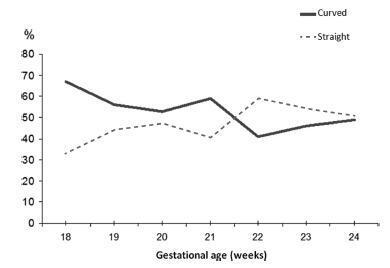You searched for:"Sebastião Freitas de Medeiros"
We found (18) results for your search.Summary
Rev Bras Ginecol Obstet. 2004;26(8):627-632
DOI 10.1590/S0100-72032004000800006
OBJECTIVE: to establish the rate of toxoplasmosis soroprevalence in postpartum women, attended in two hospitals of the Public Health System (SUS) in Cuiabá, and its correlation with age, previous abortion and women's knowledge of the disease. METHODS: a cross-sectional study including 205 women with ages from 14 to 43 (mean 22.4) years old, attended in these hospitals for two months, in the first or second days postpartum. Each woman answered a short questionnaire and had peripheral blood sample collected. Blood samples were stored at 20°C until assay. The seroprevalence was determined by quantitative detection of specific IgG antibody against Toxoplasma gondii, using a microparticle enzyme immunoassay. All samples were assayed at the same time. RESULTS: The average number of pregnancies in the women included in this study was 2.2, and the majority of them was pregnant for the first time. The seroprevalence found was 70.7% (165 of 205 women). No statistical correlation was found between seroprevalence and age (p = 0.967) or previous abortion (p = 0.82). Most of the women in this study (78%) did not know about toxoplasmosis and no statistical correlation was found between this condition and seroprevalence (p = 0.49). CONCLUSION: the high seroprevalence found in the present study is in accordance with surveys previously reported in our country and other developing countries. Among the women included in this study, an expressive number (29.3%) is still under risk of contamination. The lack of statistical correlation between seroprevalence and women's age, lack of knowledge about the disease and report of previous abortion is in accordance with some previous studies and in disagreement with others.
Summary
Rev Bras Ginecol Obstet. 2017;39(12):663-669
To examine the role of the panoramic mandibular radiograph in the diagnosis of low bone mineral density (BMD) in postmenopausal women.
A cross-sectional study including volunteer women aged over 40 years in amenorrhea due to ovarian failure for at least 12 months, who were cared for at the climacteric outpatient clinic of a university hospital in the city of Cuiabá, in the state of Mato Grosso, Brazil. The panoramic radiographs were evaluated using a specific software. Two aspects were analyzed in the mandibular panoramic radiograph: a qualitative aspect regarding the shape of the mandibular cortical bone, and a quantitative aspect regarding thewidth of themandibular cortical bone. Themorphology of themandibular cortical bone in the digital panoramic radiograph was determined bilaterally by the observation of the bone structure between the mental foramen and the base of the jaw. The mandibular cortical bonewas categorized into three groups. Themental index (MI)was used to evaluate the thickness of themandibular cortical bone through a perpendicular line drawn fromthe base of the mandible at the height of the center of the mental foramen, with another line drawn tangent to the inferior border of the mandible, and a third line parallel to the line at the superior border of themandible. The MI data are expressed in millimeters, with a normal value of 3.0 mm. The densities of the lumbar spine and femur, expressed in g/cm2, were categorized as normal, osteopenia or osteoporosis.
The agreement index between the MI and the BMD of the lumbar spine was good (Kappa = 0.718), but the same index between the MI and the BMD of the femoral neck was poor (Kappa = 0.443). An excellent agreement occurred when the mandibular cortical index (MCI) was compared with the BMD of the lumbar spine (Kappa = 0.912). The agreement between MCI and the BMD in the femur was moderated (Kappa = 0.579).
The radiomorphometric indices evaluated in the mandibular panoramic radiograph are capable of identifying postmenopausal women with low mineral density in the mandible, and the results can be used to refer these women to appropriate medical investigation and/or treatment.
